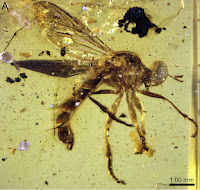Clown Beetles, Histeridae, are a diverse group of carnivorous Beetles found across the globe. They are easy to distinguish, the elytra (wing cases) that do not cover the ends of their abdomens and club-like tips to their antennae. They occupy a wide range of ecological niches, with most species feeding on other Arthropods and small invertebrates, though other specialize in the carrion of larger animals (and in some cases are used by forensic entomologists to help determine how long bodies have been dead). The group has a reasonable fossil record, with numerous fossils, predominantly in amber, from the Oligocene onwards, though these are not for the most part well studied and the origins of the group are obscure.
In a paper published in the journal Zootaxa on 2 December 2015, Michael Caterino of the Department of Agricultural and Environmental Sciences at Clemson University and Karin Wolf-Schwenninger and Günter Bechly of the Staatliches Museum für Naturkunde describe a new species of Clown Beetle from a piece of clear amber from the Middle Cretaceous of Hukawng Valley in Kachin State, Myanmar ('Burmese Amber').
The new species is named Cretonthophilus tuberculatus, where 'Cretonthophilus' refers to its Cretaceous origin and similarity to the modern genus Onthophilus, and 'tuberculatus' refers to the numerous tubercles on the head and pronotum (plate covering the back of the thorax). It is a 1.7 mm beetle of unknown sex with a heavily sculpted surface (which in modern Clown Beetles is generally associated with burrowing), though to be about 98.79 million years old.
Cretonthophilus tuberculatus, specimen in dorsal view. Caterino et al. (2015).
See also...
 Sixteen new species of Scale Insects from Cretaceous and Eocene ambers. Scale Insects are Hemipteran plant-parasites, closely related to
Aphids. There are over 7900 living species, as well as an extensive fossil
record, dating back to the Early Cretaceous. Most of the taxonomy of recent
Scale Insects is based upon studies of the larger, wingless females, while most
taxonomic studies of fossil groups has been based upon the smaller winged
males...
Sixteen new species of Scale Insects from Cretaceous and Eocene ambers. Scale Insects are Hemipteran plant-parasites, closely related to
Aphids. There are over 7900 living species, as well as an extensive fossil
record, dating back to the Early Cretaceous. Most of the taxonomy of recent
Scale Insects is based upon studies of the larger, wingless females, while most
taxonomic studies of fossil groups has been based upon the smaller winged
males... Robber Flies from Cretaceous amber. Robber Flies (Asilidae) are True Flies (Diptera) noted for their
aggressive predatory behaviour, which includes taking other Insects on
the wing. They are stout, bristly Flies, found across the globe other
than in the Antarctic, but favouring open grasslands. Robber Flies can
be quite large, with most species over 1 cm in length, and the biggest
exceeding 5 cm. The Group have a fossil record dating back to the Early
Cretaceous, with...
Robber Flies from Cretaceous amber. Robber Flies (Asilidae) are True Flies (Diptera) noted for their
aggressive predatory behaviour, which includes taking other Insects on
the wing. They are stout, bristly Flies, found across the globe other
than in the Antarctic, but favouring open grasslands. Robber Flies can
be quite large, with most species over 1 cm in length, and the biggest
exceeding 5 cm. The Group have a fossil record dating back to the Early
Cretaceous, with... A Pine Cone Weevil from Cretaceous Burmese amber. Pine Cone Weevils (Nemonychidae) are thought likely to be the oldest
group of surviving Weevils (Curculionoidea), making their understanding
their evolution important for our understanding of...
A Pine Cone Weevil from Cretaceous Burmese amber. Pine Cone Weevils (Nemonychidae) are thought likely to be the oldest
group of surviving Weevils (Curculionoidea), making their understanding
their evolution important for our understanding of...
Follow Sciency Thoughts on Facebook.

